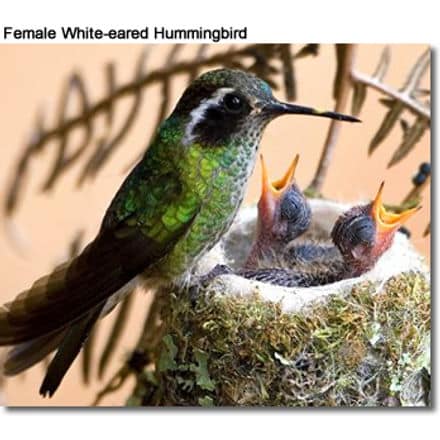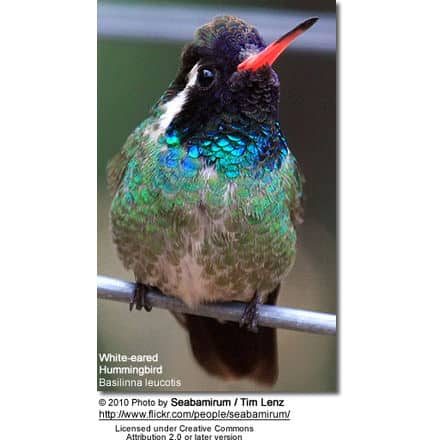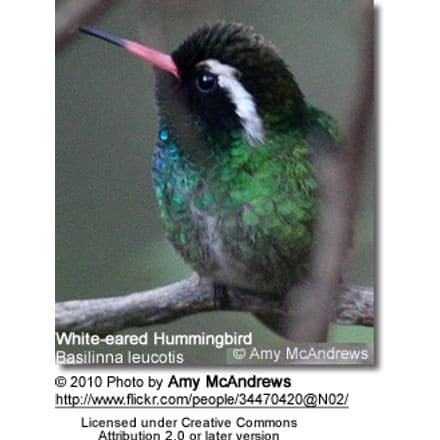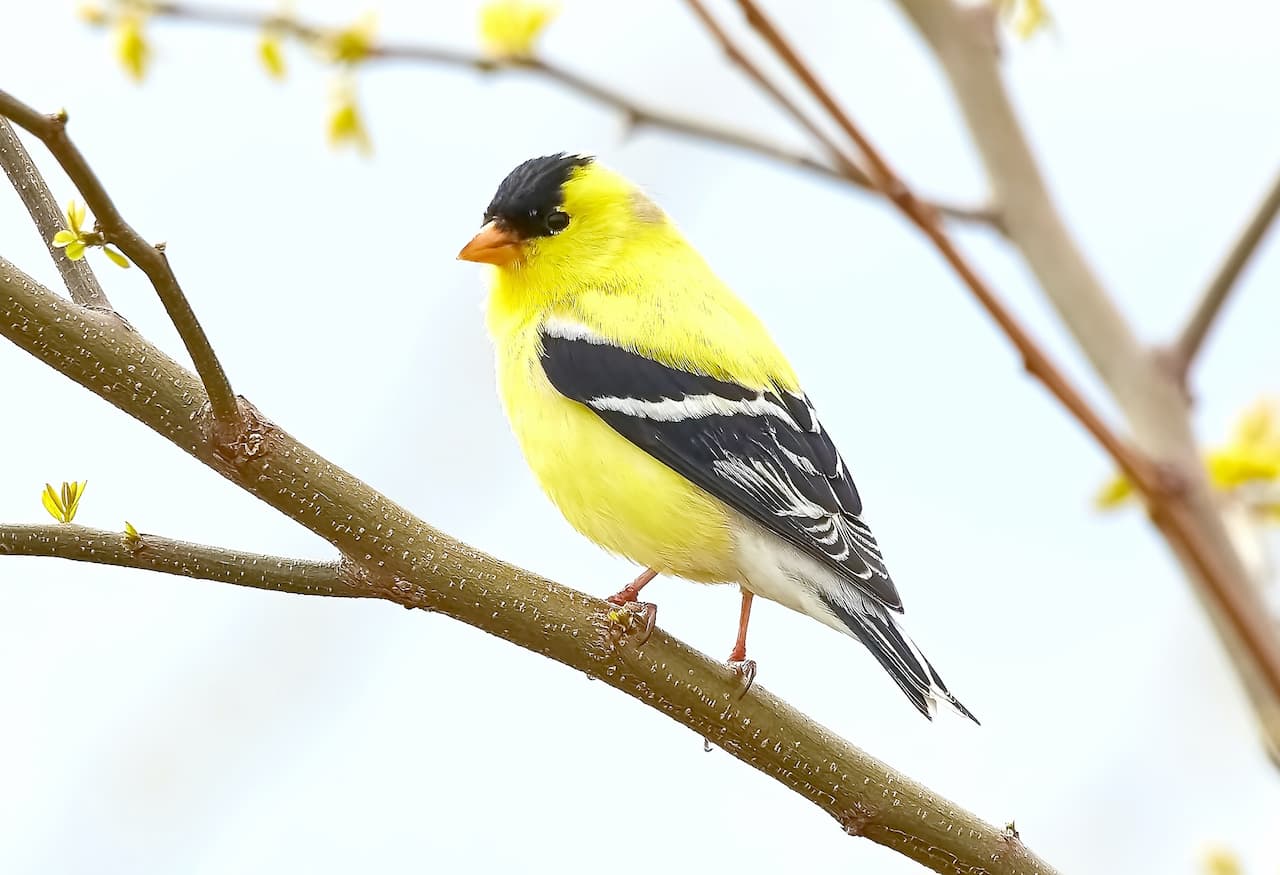White-eared Hummingbirds (Basilinna leucotis)
The White-eared Hummingbirds (Basilinna leucotis) is also known as zafiro oreja blanca (Spanish name – translated: sapphire white ear) – both of which refer to its most distinctive feature – the white line stretching from its eyes across its ears down to the chest.
Alternate (Global) Names
Spanish: Chupaflor orejiblanco, Colibrí orejiblanca, Colibri Orejiblanco, Colibrí Orejiblanco, Zafiro Bicejudo, Zafiro de Orejas Blancas, Zafiro Oreja Blanca … Italian: Colibrì guancebianche, Colibrì orecchiebianche … French: Basilinna leucotis, Colibri à oreilles blanches, Saphir à oreilles blanches … German: Purpurstirn-Saphirkolibri, Weißohrsaphir, Weissohr-Saphir … Danish: Hvidøret Safir … Finnish: Juovasafiirikolibri … Dutch: Witoorsaffierkolibrie, Witoor-saffierkolibrie … Norwegian: Hvitørekolibri … Swedish: Vitörad kolibri … Polish: szafirek bialouchy, szafirek bia?ouchy … Czech: Kolibrík belouchý, kolib?ík b?louchý … Japanese: mimijirosafaiahachidori, ????????????? … Russian: ???????? ?????? … Slovak: kolibrík borinový … Chinese: ????
Recognized Subspecies and Distribution:
- Basilinna leucotis leucotis (Vieillot, 1818) – Nominate race
- Range: highlands of central and south Mexico to Guatemala.
- Basilinna leucotis borealis (Griscom, 1929)
- This northernmost subspecies occurs in north Mexico (Sonora, Chihuahua, Tamaulipas). It is rarely found in the southwestern USA (mostly southeastern Arizona).
- Basilinna leucotis pygmaea (Simon and Hellmayr, 1908)
- This southern subspecies migrates all the way south to Nicaragua. They occur in the highlands of El Salvador, Honduras, and Nicaragua.

Distribution / Range
The White-eared Hummingbirds have a wide range that includes Canada, the United States, Mexico, Guatemala, Honduras, El Salvador, Nicaragua, Belize, and Costa Rica.
Migratory populations typically arrive at their breeding location in late March to late April and leave for their winter location by October to winter in Mexico.
They breed in southeastern Arizona (Huachuca Mountains: Miller Canyon, Ramsey Canyon – stray to White Mountains, the Mogollon Rim, and the Madrean sky islands), western and southwestern New Mexico, and west Texas in the USA; Sierra Madre Oriental (northwestern Mexico), Sierra Madre Occidental (western Mexico), Cordillera Neovolcanica (a mountain range across central Mexico), southern Mexico to southern Nicaragua.
White-eared Hummingbirds occurred as vagrants eastward to Mississippi and Michigan. They could conceivably have reached Massachusetts as well.
Resident (non-migratory) populations exist in central Sonora (a state located in northwest Mexico) south to southern Central America.
Their preferred habitat is mountain oak forests.
Description
This medium-sized hummingbird averages 9-10 cm (3.5 – 3.9 inches) in length and weighs approximately 3-4 g (0.10 – 0.14 oz).
Common Physical Traits: The upper plumage and chest of the adult are mostly green. The undertail feathers are mostly white. The tail is dark and straight.
Their bills are long, thin, and straight, with red at the base. The most distinctive feature is their white ear stripe for which this species was named. It is more boldly colored in the male.
The adult male: His throat is a metallic turquoise green-blue. His crown and face are violet and black. His back is deep green with a rusty wash. Their slightly notched tail is bronze-green – the outer feathers are darker. His lower abdomen and undertail feathers are whitish.
The bill of the male is short, straight, and very slender. It is red with a fairly small black tip. A broad blue-violet band encircles the base of the bill in mature males.
The adult female is less colorful than the male. Her pale-cream colored throat has golden-green to turquoise green speckles. Her back and crown (top of the head) are deep green.
She has a broad white line behind the eye with a broad blackish stripe below. Her under plumage is buffy-white spotted with green. Her tail feathers (rectrices) look like the male’s, but the lateral ones are tipped with greyish-white.
Her bill is black with some red-orange at the base. Her tail is slightly notched and her outer tail feathers are tipped whitish.
Juveniles: Immature birds usually attain their adult plumage when they are 2 years old or older. Younger birds (juveniles) look similar to the females – both in coloring and size.
However, the immature female shows distinct pale feather edges and has a darker bill. The immature male has a distinct green patch on his throat and there is more red on his bill.
Similar species: Female and juvenile White-eared Hummingbirds look similar to the female and juvenile male Broad-billed hummingbirds – but they have a longer, stouter bill; they have a proportionally smaller and more rounded head.
Nesting / Breeding
Hummingbirds are solitary in all aspects of life other than breeding, and the male’s only involvement in the reproductive process is the actual mating with the female. They neither live nor migrate in flocks, and there is no pair bond for this species.
Males court females by flying in a U-shaped pattern in front of them. He will separate from the female immediately after copulation. One male may mate with several females.
In all likelihood, the female will also mate with several males. The males do not participate in choosing the nest location, building the nest, or raising the chicks.
The female is responsible for building the cup-shaped nest out of plant fibers woven together and green moss on the outside for camouflage in a protected location in a shrub, bush, or tree.
She lines the nest with soft plant fibers, animal hair, and feathers down, and strengthens the structure with spider webbing and other sticky material, giving it an elastic quality to allow it to stretch to double its size as the chicks grow and need more room. The nest is typically found on a low, thin horizontal branch.
The average clutch consists of two white eggs, which she incubates alone for about 14 to 16 days, while the male defends his territory and the flowers he feeds on. The young are born blind, immobile, and without any down.
The female alone protects and feeds the chicks with regurgitated food (mostly partially digested insects since nectar is an insufficient source of protein for the growing chicks). The female pushes the food down the chicks’ throats with her long bill directly into their stomachs.
As is the case with other hummingbird species, the chicks are brooded only the first week or two and are left alone even on cooler nights after about 12 days – probably due to the small nest size. The chicks leave the nest when they are about 23 – 26 days old. The female White-eared raises two broods each year.
Diet / Feeding
The White-eared Hummingbirds primarily feed on nectar taken from a variety of brightly colored, scented small flowers of trees, herbs, shrubs, and epiphytes.
They favor flowers with the highest sugar content (often red-colored and tubular-shaped) and seek out, and aggressively protect, those areas containing flowers with high-energy nectar.
They use their long, extendible, straw-like tongues to retrieve the nectar while hovering with their tails cocked upward as they are licking at the nectar up to 13 times per second. Sometimes they may be seen hanging on the flower while feeding.
Many native and cultivated plants on whose flowers these birds feed heavily rely on them for pollination. The mostly tubular-shaped flowers exclude most bees and butterflies from feeding on them and, subsequently, from pollinating the plants.
They may also visit local hummingbird feeders for some sugar water, or drink out of bird baths or water fountains where they will either hover and sip water as it runs over the edge; or they will perch on the edge and drink – like all the other birds; however, they only remain still for a short moment.
They also take some small spiders and insects – important sources of protein particularly needed during the breeding season to ensure the proper development of their young. Insects are often caught in flight (hawking); snatched off leaves or branches, or taken from spider webs. A nesting female can capture up to 2,000 insects a day.
Males establish feeding territories, where they aggressively chase away other males as well as large insects – such as bumblebees and hawk moths – that want to feed in their territory. They use aerial flights and intimidating displays to defend their territories.







